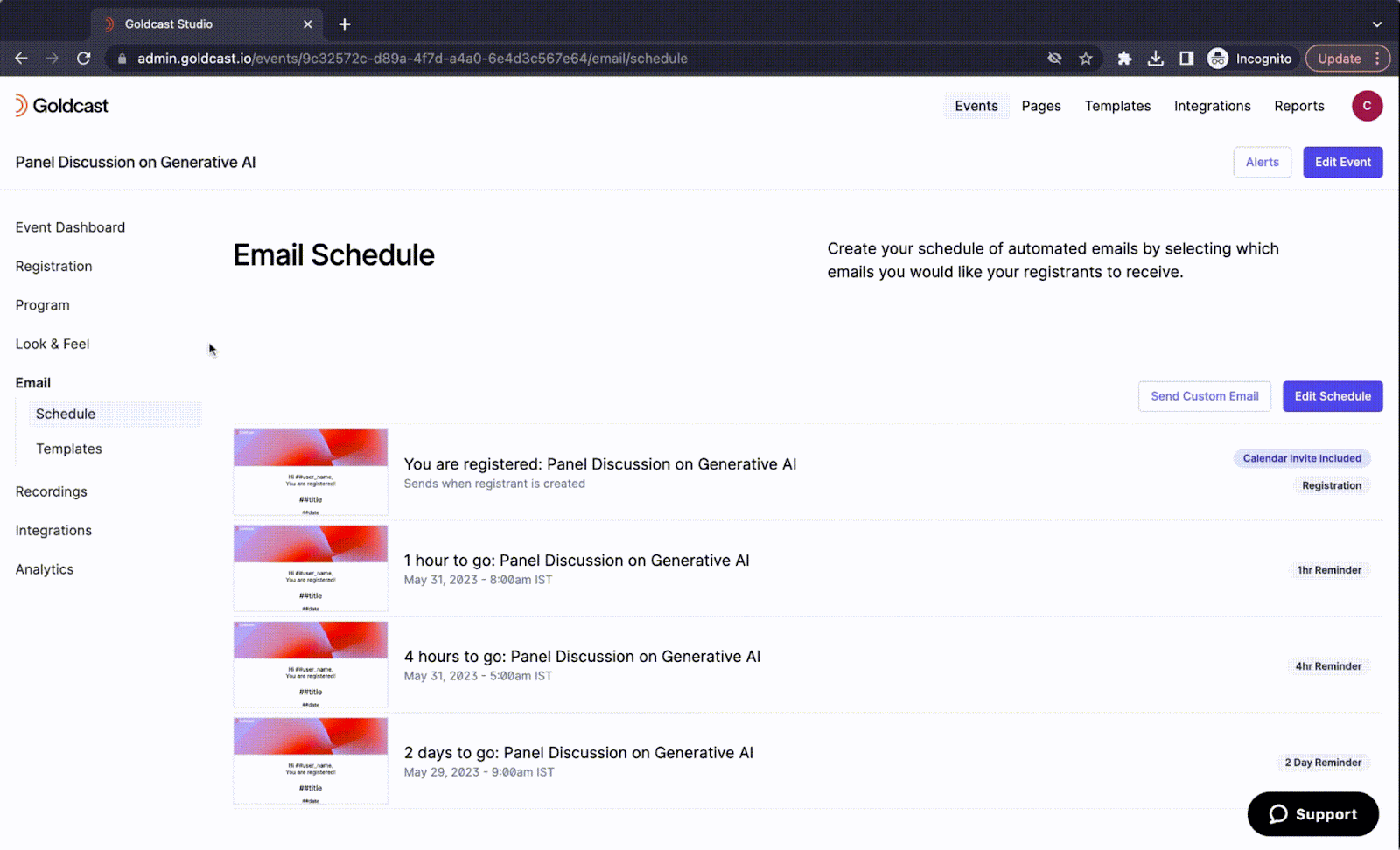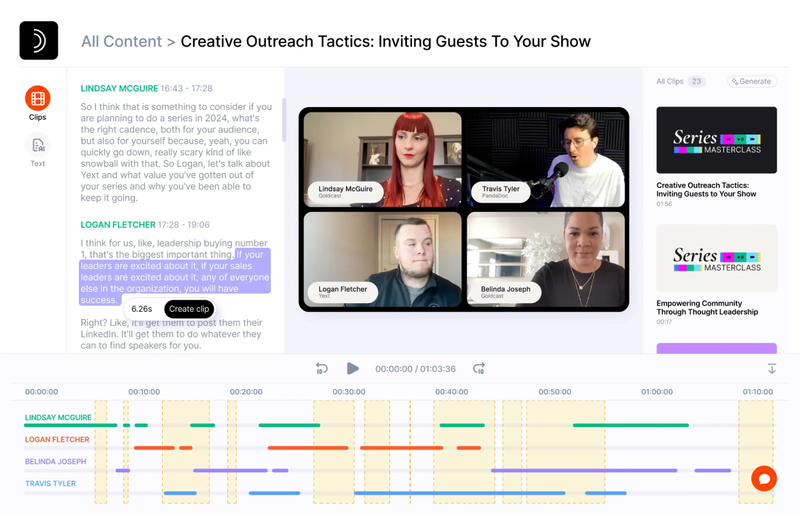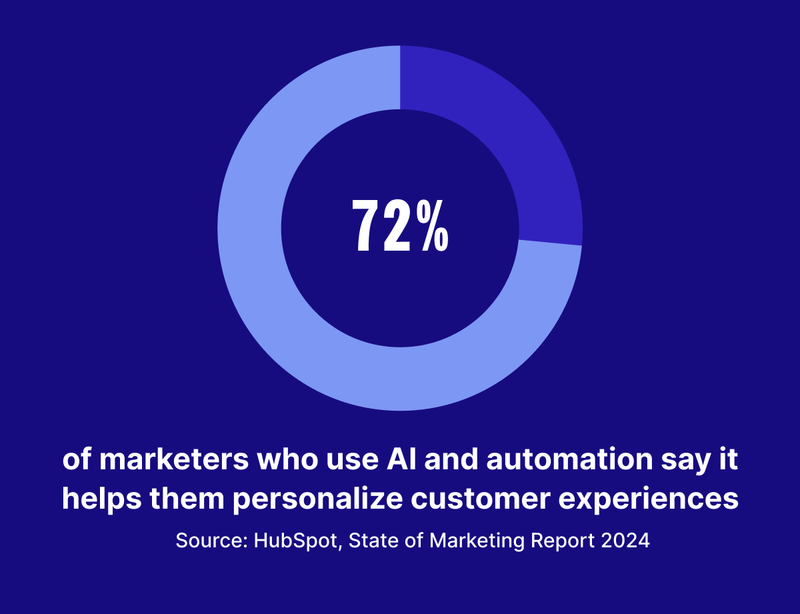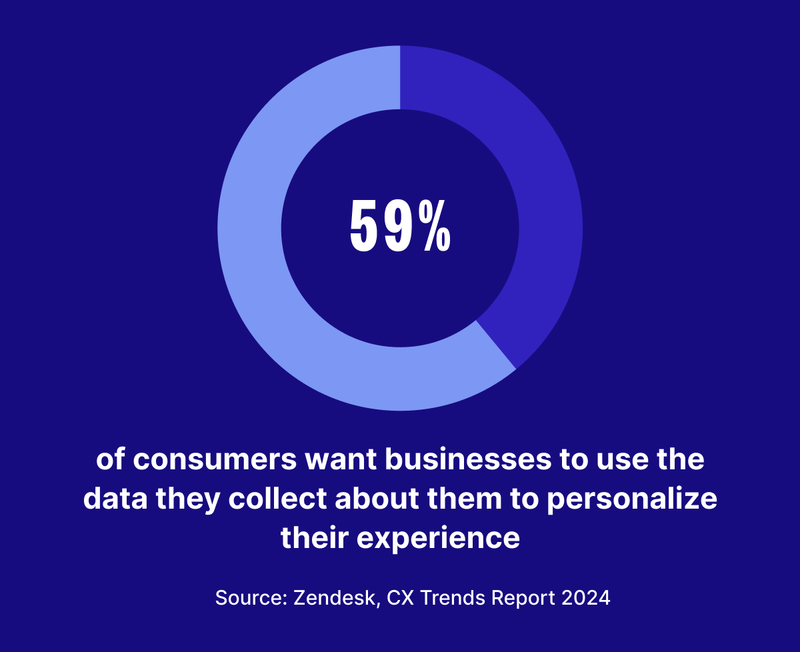B2B Marketing Automation: The Fundamentals (2024)
Table of Contents
- What is B2B marketing automation?
- B2B marketing automation examples
- 7 tips to make the most of B2B marketing automation
- Beyond B2B marketing automation software: recapping the benefits of automation
- How Goldcast supports leading B2B marketing automation platforms
- Your new marketing automation strategy starts here
Maximize Your Marketing ROI
Join 10,000 other marketers already getting the best tips on running engaging events that boost pipeline and create raving fans.
The B2B marketing game has fundamentally flipped. Automation has gone from an ad hoc backend process to the critical connective tissue between sales and marketing. And a central element of every revenue team.
In this guide to B2B marketing automation, we’ll cover the core fundamentals, share practical day-to-day examples and reveal the latest best practices for leveraging automation to scale your demand gen and capture efforts.
What is B2B marketing automation?
B2B marketing automation is the use of software to automate repetitive marketing tasks. It can include everything from sending out email campaigns to managing data entry and lead scoring. By using customized workflows and triggers, automation tools can streamline operational responsibilities and free marketers to focus on strategy and creativity.
For marketers with an active event strategy, automation can be especially beneficial. With the right tools and processes, you can configure a post-event lead flow that delivers more value to attendees while measuring the real impact of your events on pipeline.
B2B marketing automation examples
B2B automation can boost your marketing ROI by helping you find the most time- and resource-saving ways to launch and track your campaigns.
But in order to take automation from just another tool to a genuine ROI lever for your team, you’ll need to know where to start and what to optimize.
Here are some real world examples of B2B marketing automation in action.
Automated confirmation email
Nothing sets the stage for a positive customer experience like the welcome email. This is the initial interaction your prospect has with your brand. And it can absolutely impact their future engagement.
“We know from FullStory’s global consumer survey, when customers experience a digital problem or frustration, 64% report that they’re likely or very likely to leave without completing their transaction. They're not giving you another try,” explains Georgianne Parker, Senior Manager, Events & Field Marketing at FullStory.
When Georgianne and her team switched digital event platforms to one with more automation and personalization features, they immediately saw an increase in ROI:
- 8X return in qualified pipeline from webinars
- Grew average webinar registration from 75 to 360
- Reduced event setup time from six hours to 15 minutes
- Increased attendance rate from 44% to 77%
- Eliminated manual Marketo setups and saved 30 minutes per event
“Primarily we wanted to create a good digital experience for those people attending our events, starting with registration all the way through to reminders to attending the actual event and then the post event process as well,” says Georgianne.
With a glitch-free confirmation process at the start of the journey, Fullstory’s audience was happy to continue engaging with their brand throughout the lead qualification process.
Automated email sequence
Today there is endless martech dedicated to demand conversion. But the right automation can also help you create and capture demand by inviting your prospects into an engaging dialogue using branded email templates that look and feel exactly how you want them to.
After launching their annual Beyond event, Katie Dunn, Senior Demand Generation Manager at ThoughtSpot, automated all event reminders via Goldcast, including:
- The registration confirmation email
- What to expect email (~10 days later)
- 24-hour reminder (day before)
- Here's your magic link email (day of event)
- Follow up email
With one automated email sequence, Katie and her team saw 1,140 people register to attend Beyond virtually and 615 attended live. That’s a show rate of almost 50%.

“In the Analytics, you can see how you're trending with registration. You can actually see where you had a spike in registrations because you had an email go out. It's like a full, complete view where you're getting registrations in from,” says Katie.
From one virtual event, she and the team made the following impact on pipeline:
- 1,000+ leads generated
- 644 MQLs
- 357 SALs
- 17 Meetings Booked
- 11 Opportunites Created
- $1.56 M Pipeline Created
- $4.27 M Pipeline Influenced
Katie focuses on three core areas to measure her success: attendee experience, engagement tracking, and sponsor experience. From there, she and the demand gen team are focused on performance and scalability.
“Obviously, registration number is super important, but the second follow there is how many people attended live. That's going to inform how SDRs follow up. Virtual attendance is a key indicator of someone's interest and helps sales tailor follow up,” she explains.

Lead scoring and status changes
With the right B2B automations in play, you can easily capture all the data you need to guide your lead scoring and follow ups.
In Goldcast, we capture attendee engagement scores using 13 activity points that can be aligned with your lead scoring model to demystify your attribution from digital events.
If you’re using Salesforce Pardot to score and route leads, you can:
- Filter and sort by contact owner: Sort event leads by sales rep for an instant view of who’s responsible for following up with who.
- Filter by CTA clicks: These folks are ready to talk. Sort by CTA clicks to help sales prioritize top accounts for follow up.
- Filter by poll response: Detailed data like Q&A and poll responses gives marketing and sales teams ammunition for value-led follow up.
By syncing custom event activities like registration, attendance, and engagement to specific campaigns within Salesforce, you can see exactly how your events are influencing pipeline and revenue.
Audience segmentation and lists
B2B marketing automation unlocks the free flow of data between sales and marketing teams, making it easy to segment lists without getting slowed down by manual gruntwork in between tasks.
For post-event lead generation, this can be as simple as segmenting your audience list into three main categories:
- Attendees
- Demo attendees
- No shows
With automatically segmented lists, you can go from event to follow up by passing ready-to-bite demo attendees straight to sales team, and tailoring dedicated email follow up for attendees and no shows.
Automated content repurposing
Revenue is a beautiful thing. But marketing automation ROI doesn’t stop at pipeline.
With tools like Goldcast Content Lab, B2B companies like AspenCore, SnapLogic, Modern Sales Pros and Qualio are repurposing their digital event content for podcasts, videos, blog posts, ads, and more, to fuel their a range of marketing channels.
“Content Lab is such a game changer because it does all the work for you. It gives me five immediate short videos that we can use on our social media platforms to increase engagement. In the past, we had to do it all manually, if at all, because we were prioritizing other things,” says Ashley Sherrick, Senior Growth Marketing Manager at Qualio.

7 tips to make the most of B2B marketing automation
B2B marketing automation is about so much more than building forms and emails. With the right automations in place, you can identify new revenue opportunities and make a bigger impact with each and every element of your marketing operation.
Here are some prime areas for automation.
1. Lead tracking
Marketing automation tools can help track leads throughout the sales funnel, capturing their interactions along the way and feeding that data directly into your lead scoring systems.
This can help you streamline the lead tracking process, while providing real-time insights into lead behavior, allowing for personalized follow ups and better lead management.
2. Lead nurturing
These days, there’s no excuse for a lack of relevant lead nurturing. According to research from HubSpot, 72% of marketers who use AI and automation say it helps them personalize customer experiences.
With the right combination of tools, you can implement automated email campaigns triggered by lead behavior, demographics, or buying stage, to nurture leads with relevant content and drive the pipeline forward.
3. Email marketing
Generic emails are officially a thing of the past. To stand out in an avalanche of messages, you need to embrace email marketing automation that is grounded in specific lead behavior, segmentations, and engagement levels.
Here again, automation can be a game changer. By improving email relevance, you can increase your open and click-through rates, run regular A/B testing, and boost your overall email marketing performance.

4. Lead scoring
Manual lead scoring tasks used to take hours, causing a major delay in follow up with warm leads.
With B2B marketing automation, you can implement lead scoring models based on a number of data points, including demographic data, engagement metrics, and lead behavior, to prioritize leads in a fraction of the time.
5. Customer profiling
Did you know that 59% of consumers actually want businesses to use the data they collect about them to personalize their experience?
Automation in customer profiling enables personalized marketing strategies, improves customer experiences, increases customer engagement and expands lifetime value. With data enrichment tools that leverage the power of AI and automation, you can gather, analyze, and update customer profiles for better targeting, personalization, and ad ROI.
6. LinkedIn and CRM synergy
LinkedIn is the online water cooler where prospects go to take a break and connect.
With automated lead generation forms and campaigns, you can send data from LinkedIn straight into your customer relationship management (CRM) systems to streamline lead capture and qualification.
7. Extending ROI
Leverage automation to track and analyze marketing campaign performance, attribution, and ROI metrics across channels and programs.
Automation of ROI measurement provides valuable insights into campaign effectiveness, identifies high-performing channels, optimizes marketing spend, and ensures maximum ROI on your marketing efforts.

Beyond B2B marketing automation software: recapping the benefits of automation
Setting up B2B marketing automations can take time, but it’s worth it. Here are just some of the benefits you can capture through smart marketing automation.
Handle larger lead volumes
Automation helps you manage more leads, more efficiently. By taking repetitive tasks off your plate, you can focus on crafting engaging content, personalizing interactions, and making sure no opportunities fall through the cracks.
Minimize waiting time for warm leads
Quick follow-ups are crucial. Automation triggers instant responses to drive your account-based marketing forward, like sending follow-up emails or alerting sales reps to key questions and engagement activities.
Personalize at scale
Automation lets you create personalized experiences for prospects without manual effort. Use dynamic content and segmentation to send tailored messages and boost the ROI on your campaigns.
Optimize your sales funnel
Automation streamlines your sales funnel by nurturing leads systematically. It guides prospects through the customer journey, prioritizing high-value opportunities with intelligent lead scoring based on your criteria.
Gain insights and measure success
Automated systems provide valuable customer data and analytics to the folks who need it, when they need it. Use these insights to fuel your sales efforts, improve your strategy, and make informed decisions to optimize ROI.
How Goldcast supports leading B2B marketing automation platforms
Let’s take a closer look at some of the top marketing automation platforms (MAPs) and how they can be used to increase your ROI.
HubSpot + Goldcast
With the powerful combination of HubSpot and Goldcast, you can create dynamic lists, score leads, and trigger automated workflows based on the actions of registrants and attendees.
Use your UTMs to seamlessly track campaigns, see the complete Timeline Activity of each contacts’ participation at your events, automatically push qualified prospects straight from Goldcast to HubSpot to Salesforce, and drill down into deal amounts and opportunities generated from your events.
Set-up takes only 6 minutes.
Salesforce + Goldcast
If you’re already using Salesforce, pulling your event data straight from Goldcast can help you sync data from 16 different event activities for instant insights about prospect engagement and performance.
You can create lists and prioritize outreach by activities like CTA clicks and poll responses to follow up with the hottest leads first. And with robust analytics, you can continue to use Salesforce as your single source of truth for reporting—without having to switch back and forth between platforms.
And the best part? Setup is super straightforward.
Marketo + Goldcast
With Marketo and Goldcast working together, you can track registrants and attendees and trigger workflows based on their interaction and engagement.
Automate data sync at the event/program level, use UTMs to seamlessly track sources and campaigns, trigger automated follow-ups based on attendee activity, and push qualified prospects straight from Goldcast to Marketo to Salesforce.
Simply install the Marketo app in Goldcast, map your fields to automate workflows, and you’re ready to roll.
Oracle Eloqua + Goldcast
By integrating Goldcast with Eloqua, you can develop comprehensive customer profiles, craft engaging marketing campaigns, implement relevant follow-up actions, generate high-quality leads and more.
Connecting your Eloqua account to Goldcast can happen in just three simple steps.
Goldcast’s integrations with CRMs and B2B marketing automation tools such as HubSpot, Marketo and Salesforce make it easy for you to optimize your event ROI and generate more engagement (and pipeline!) in less time. And with deep data insights, you also get end-to-end event data visibility for your revenue team.
Your new marketing automation strategy starts here
“If you're in marketing operations, Goldcast is next level,” says Katie Dunn of ThoughtSpot. And sure, we’re biased, but we have to agree.
With powerful functionality and the ability to automate everything from pre- and post-event communication to key lead scoring, nurturing, and qualification processes, Goldcast gives you everything you need to maximize your event ROI and fuel your marketing programs.
Find out what Goldcast can do for you. Book your free demo today, or request a trial of Content Lab to see the power of automated content repurposing in action.
Transform Your Video Marketing with AI
Stay In Touch
Platform
Resources
© 2025 Copyright Goldcast, Inc. All rights reserved.





 Upcoming Events
Upcoming Events Event Series
Event Series On-Demand Events
On-Demand Events

